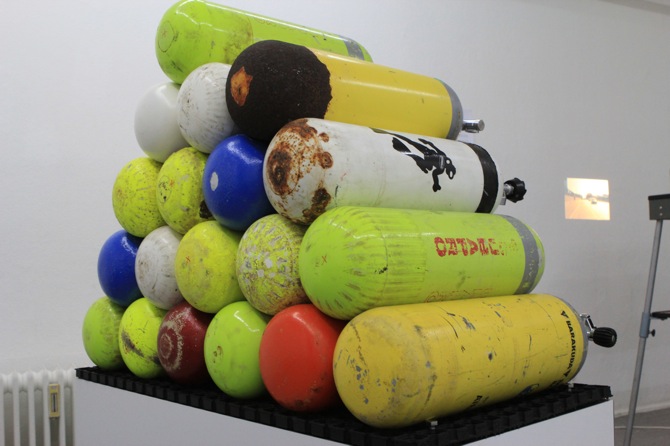
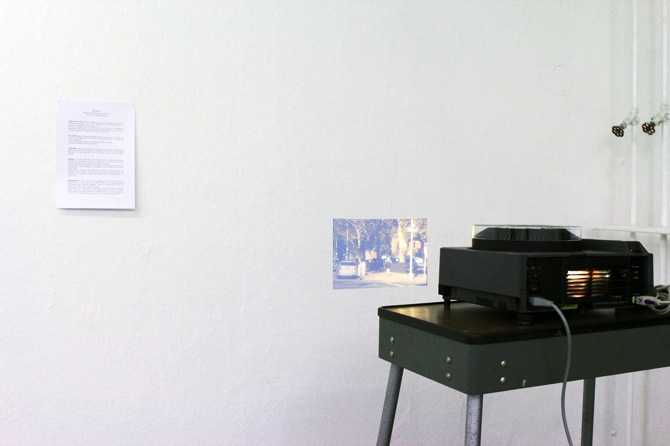
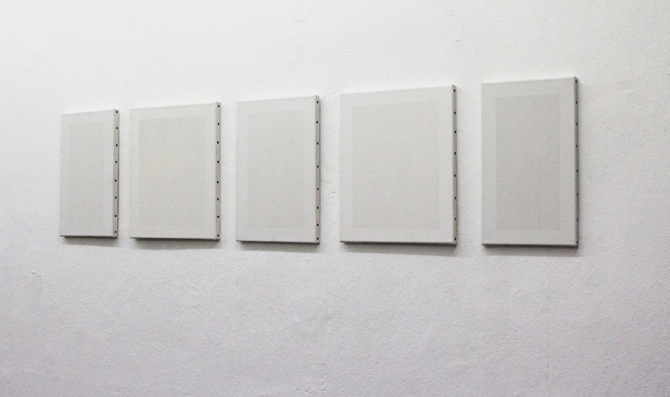
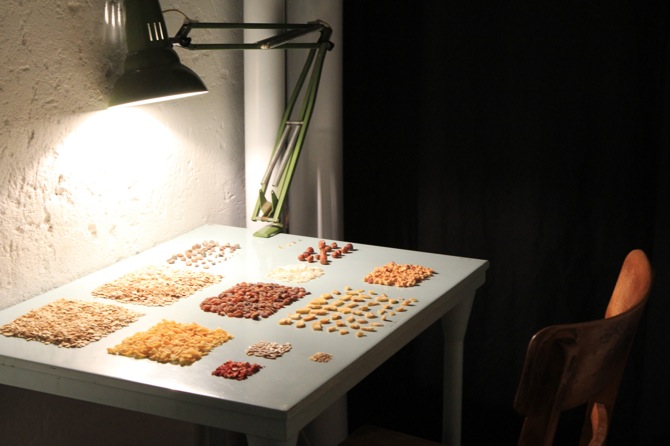
from the top: Klara Hobza “From Cologne to Bonn” (2011). Courtesy Galerie Soy Capitän // Guido van der Werve, "Nummer dertien, Effugio A: Chamomile, Russia's National Flower or Running to Rachmaninoff" (2010)" // Isabelle Giovacchini “about:blank” (from 2008) // Moritz Frei "Divide et impera" (2011-13) // courtesy the artists // photos by insitu
They say the devil finds work for idle hands. Leisure, unproductiveness and extensive pondering contradict the modern belief in efficiency and optimisation. Only within the sphere of creative productions – specifically literature, music, theatre, film and visual arts – there exists a legitimation of (temporary) faineance for the sake of brilliant results and unique genius. On the other hand, however, the arts originate from a tradition of hard labour and craft, which still influences the appreciation of contemporary artists. "Episode 4: Tireless Workers", the current group show at the relatively new Berlin-based project-space insitu, discusses these clichés and phenomena by showcasing possibilities of approaching the production of art with seemingly senseless and repetitive manual labour.
During the opening of the exhibition, the artists Moritz Frei sits in front of desk inside a small and dark niche. An office lamp lights the table. He slowly empties the content of a cereal box and separates nuts, raisins, grain in small squares, neatly arranges them by size and type. The monotonous task takes him four hours. Frei's performance “Divide et impera” (a Latin phrase meaning "divide and rule") emphasises the contradiction of dissipation: the organising of a chaotic and entropic system on the one side and the liberty of wasting time with an ostentatiously useless occupation on the other. As for the absurdity in his occupation, his ironic comment also applies to the nitpicker – an allegory of a pedant of formal bureaucracy.
The aspect of repetitive production in Frei's performance is also targeted in the five white and plain canvases by Isabelle Giovanicchi. While the performance ends in an absurd, but nevertheless strikingly aesthetic object, Giovanicchi' series "about:blank" has – as the title suggests it – an almost invisible surface. Transforming the process into a daily ritual, the artist accurately punctured each canvas in a geometric pattern. While both, Frei's cereal-environment and Giovanicchi's pierced canvases appear to be the result of an autistic repetition compulsion, the object "From Cologne to Bonn" by Klara Hobza refers to an athletic ambition: a staple of colourful oxygen bottles visualise the amount of oxygen needed, if she would dive from the city of Cologne to Bonn. Hobza’s long-term project "Diving Through Europe" approaches manual labour as a training – from the perspective of competitive achievements and the prevention of physical exhaustion.
As particularly shown in Mai Yamashita & Naoto Kobayashi's film "Infinity in Berlin", in which the artists document people running on the lines of the infinity symbol (∞), most of the show's works highlight the value of the artistic process, as opposed to the value of a finished product. They challenge the definition of time-waste and reconsider strategies of productivity and efficiency. Ironically, the show "Tireless Workers" appears to pledge itself to the necessity of idleness in artistic production: of slowing down, of pondering and of conscious decisions. The luxury (and the burden) of creativity.
The aspect of repetitive production in Frei's performance is also targeted in the five white and plain canvases by Isabelle Giovanicchi. While the performance ends in an absurd, but nevertheless strikingly aesthetic object, Giovanicchi' series "about:blank" has – as the title suggests it – an almost invisible surface. Transforming the process into a daily ritual, the artist accurately punctured each canvas in a geometric pattern. While both, Frei's cereal-environment and Giovanicchi's pierced canvases appear to be the result of an autistic repetition compulsion, the object "From Cologne to Bonn" by Klara Hobza refers to an athletic ambition: a staple of colourful oxygen bottles visualise the amount of oxygen needed, if she would dive from the city of Cologne to Bonn. Hobza’s long-term project "Diving Through Europe" approaches manual labour as a training – from the perspective of competitive achievements and the prevention of physical exhaustion.
As particularly shown in Mai Yamashita & Naoto Kobayashi's film "Infinity in Berlin", in which the artists document people running on the lines of the infinity symbol (∞), most of the show's works highlight the value of the artistic process, as opposed to the value of a finished product. They challenge the definition of time-waste and reconsider strategies of productivity and efficiency. Ironically, the show "Tireless Workers" appears to pledge itself to the necessity of idleness in artistic production: of slowing down, of pondering and of conscious decisions. The luxury (and the burden) of creativity.
Episode 4: tireless workers
14.11.2013 – 18.01.2014 (WINTER BREAK 21.12.2013 – 07.01.2014)
with works by Francis Alÿs (BE), David Brognon & Stéphanie Rollin (LU/BE), Moritz Frei (D), Isabelle Giovacchini (FR), Klara Hobza (D), Letizia Romanini (LU), Takahiro Suzuki (JP), Guido van der Werve (NL), Mai Yamashita & Naoto Kobayashi (JP).
Curated by Marie Graftieaux, Nora Mayr and Gilles Neiens
insitu
Kurfürstenstr. 21-22
10758 Berlin
opening hours: Wed - Fri 4 - 7pm / Sat 2 - 6pm
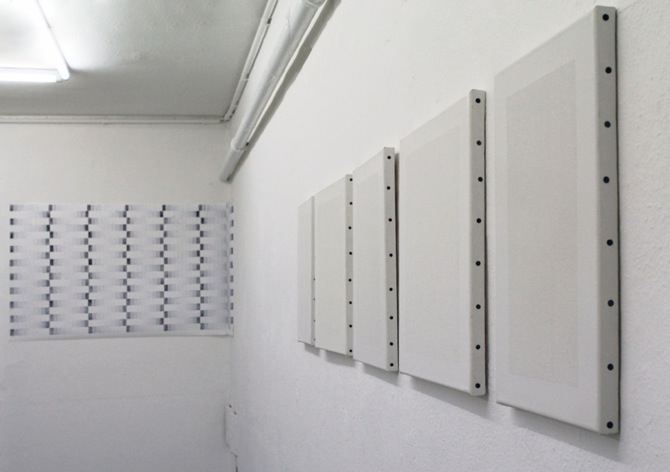
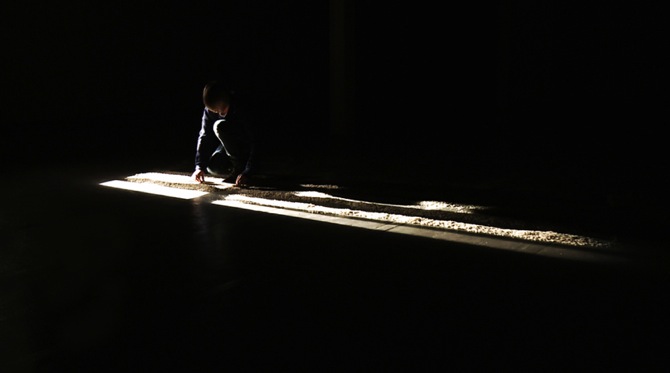
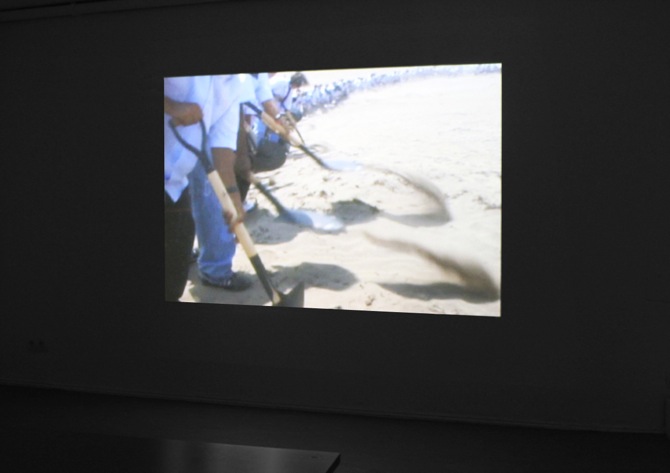
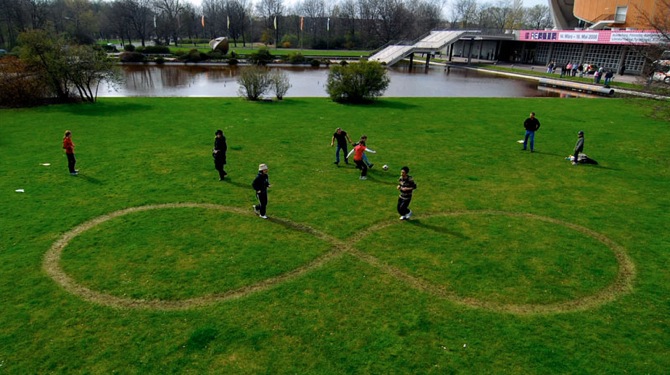 Exhibition view // David Brognon and Stéphanie Rollin "The Most Beautiful Attempt" (2012), film still // Francis Alÿs "When Faith Moves Mountains (making of)" (2002) // Mai Yamashita and Naoto Kobayashi "Infinity in Berlin" (2008), film still. // courtesy the artists // photos by insitu
Exhibition view // David Brognon and Stéphanie Rollin "The Most Beautiful Attempt" (2012), film still // Francis Alÿs "When Faith Moves Mountains (making of)" (2002) // Mai Yamashita and Naoto Kobayashi "Infinity in Berlin" (2008), film still. // courtesy the artists // photos by insitu
